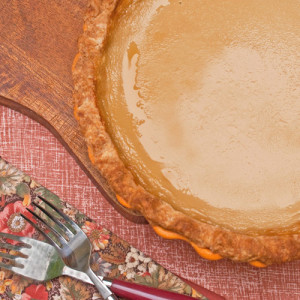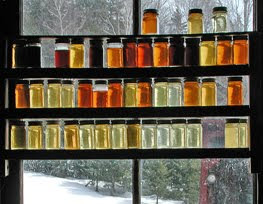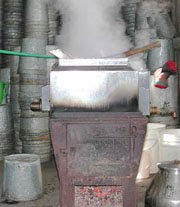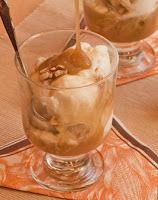 In a phenomenon scientists still don’t fully understand, the sap, which has been stored in the roots during winter flows up into the limbs during the warmer days, then drops back into the roots at night. This is what maple harvesters mean when they say the “sap is running,” and it’s the only time of year the trees can be tapped. Once the weather warms to the point the branches start to leaf, the sap develops a strong unpleasant taste and the harvesting ceases for another year.
In a phenomenon scientists still don’t fully understand, the sap, which has been stored in the roots during winter flows up into the limbs during the warmer days, then drops back into the roots at night. This is what maple harvesters mean when they say the “sap is running,” and it’s the only time of year the trees can be tapped. Once the weather warms to the point the branches start to leaf, the sap develops a strong unpleasant taste and the harvesting ceases for another year.

After seeing the maple syrup samples in the window (left) and watching sap being boiled down (pic below) at the Morse Farm in Monpelier, Vermont, I decided to do a maple version of the old-fashioned American favorite, custard pie. (For another homey seasonal sweet that skips a pie crust, check out my Maple-Nut Bars or the Morse Farm Maple Kettle Corn.)
 Tip: In the following recipe and other baked goods, it’s best to use medium or dark amber grades of maple syrup like the darker colored samples in the window: They have a more intense flavor and deeper color than the fancy, grade A light syrup. They are usually less expensive, too.
Tip: In the following recipe and other baked goods, it’s best to use medium or dark amber grades of maple syrup like the darker colored samples in the window: They have a more intense flavor and deeper color than the fancy, grade A light syrup. They are usually less expensive, too.
Smooth as Silk Maple Custard Pie
Boasting a silky-smooth texture and faintly tawny color, the custard is mild enough to enhance, not overpower the maple taste. The flavor of the real thing is milder than imitation maple flavoring, but so-o-o much better.
 1 recipe all-purpose pie dough (enough for a 9-inch pie)
1 recipe all-purpose pie dough (enough for a 9-inch pie)
Filling
3/4 cup half-and-half or whole milk
1 tablespoon cornstarch
1 cup heavy cream
3/4 cup maple syrup, preferably, medium or dark amber, plus additional for garnish, optional
4 large eggs, lightly beaten
1/8 teaspoon salt
2 teaspoons vanilla extract
To shape th:e crust: Lightly grease a regular (not deep-dish) 9-inch pie plate, or coat with nonstick spray. Unwrap the chilled dough. If it seems too stiff to roll, let it stand to warm up just slightly. Very lightly dust each side with flour. Lay the dough between sheets of baking parchment. Roll out with a rolling pin into an evenly-thick 13-inch round. Carefully peel off and discard one sheet of paper from the dough round. Center the round, dough-side down, in the pie plate. Gently peel off the second sheet and discard. Adjust the position, smooth the dough into the plate, and patch any tears, if necessary. Trim the pastry overhang to a generous 1-inch using kitchen shears or knife. Fold under the pastry overhang to form an even edge that rests on the lip of the pie plate; crimp with the fingers or decorate with the tines of a fork. Prick the pastry bottom and sides with a fork. Loosely cover the pastry and return to the refrigerator until cool and firm again, at least 15 minutes.
To par-bake the crust: Preheat the oven to 400 degrees F. Insert a large square of nonstick aluminum foil (or spray-coated regular foil) into the chilled shell, smoothing the foil over the bottom and sides and folding it out over the rim to cover the pastry. Fill the foil with dried beans or pie weights. Set the pie plate on a rimmed baking sheet. Bake in the lower third of the oven for 25 minutes. Very gently remove the foil and beans from the shell. Continue baking until the shell is lightly browned, about 5-8 minutes longer. Transfer to a wire rack.
To make the filling: Reset the oven to 325 degrees F. In a medium non-reactive saucepan whisk together the half-and-half and cornstarch until well blended and smooth. Whisk in the cream. Heat, whisking, over medium-high heat until it boils and thickens slightly, about a minute. Set aside to cool for 5 minutes. Using a whisk, beat together the maple syrup, eggs, salt, and vanilla in a large, heat-proof bowl until very well blended. Whisking, very slowly pour the hot cream mixture into the egg mixture in a thin stream to avoid overheating (and possibly curdling) the eggs. Strain the custard through a fine sieve into the pie shell.
To bake the pie: Place on a rimmed baking sheet in the middle third of the oven; bake for 15 minutes. Reduce the heat to 300 degrees F., and continue baking until the filling appears set except in the center when the pan is jiggled, about 20 to 25 minutes. Transfer the pie to a wire rack until cooled, then refrigerate, covered, at least 2 hours and up to 3 days before serving. Serve chilled, cut into wedges. For a slightly sweeter taste, drizzle the tops of the servings with a little maple syrup. Add a dollop of whipped cream, if desired. Makes 6 to 8 servings.
Perhaps you would also like these easy maple sundaes.



I have not tried to just make the custard, so can’t say for sure. But it seems like it would be possible. Of course, the baking time would be totally different–much shorter, I imagine.
Can you make this maple custard in cups instead of a pie crust?
Just when I thought I was all set with my pie choices for this year, I saw this on Pinterest. My daughter wants to make a chocolate cream pie. And I have had a sudden (rather odd) craving for key lime pie, which I figured would be a refreshing alternative to the usual pumpkin pie. But I love maple syrup and I can only imagine how good your maple custard pie is. Ah well, all dilemmas should be so delicious. Happy Thanksgiving to you!
It is very good–especially if you are a fan of real maple syrup. And it’s a great way to support the American (and Canadian) maple industry.
by the way, this looks really good